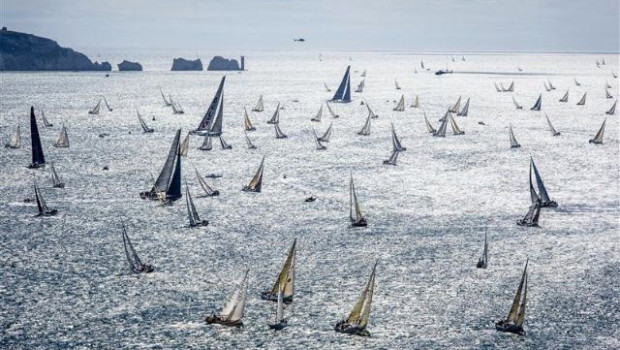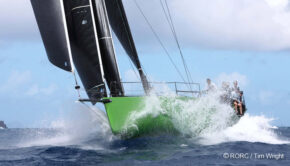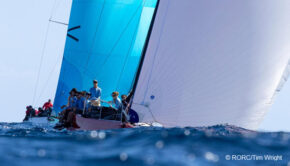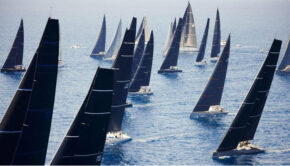IRC State of the Union
Published on October 25th, 2015
The IRC rating rule is a joint venture between the RORC rating office (GBR) and UNCL (FRA), with both offices working together to administer and evolve the handicapping system. On the British side, Mike Urwin and James Dadd share comments in the November issue of Seahorse magazine about the state of the rule.
The technical developments in yacht design must keep you busy.
MU: There have been huge changes. Twenty two years ago boats were IOR, IOR derivatives or IMS of sorts. Spinnakers were symmetric, boats had spinnaker poles and bowsprits were banned. Neither water ballast nor canting keels were permitted. Masts were aluminum. Standing rigging was steel wire or rod. DSS had not even been thought of! Powered winches were not permitted… and trimmers thumb was unheard of.
CHS (Channel Handicap System), and then IRC, led the way in allowing all these innovations that then spread elsewhere. We have always strongly held that IRC is permissive – we must embrace the modern and the new, but it is key that we must at the same time protect the existing fleet and not devalue their boats overnight… But if we do not embrace new ideas then IRC will go the way of its predecessors.
Handicap racing is always fairer between boats of a similar size. When classes like the Maxi 72, TP52 and 100-footers come up against each other under IRC how does it go…
MU: It’s reasonable, but it often comes down to conditions. The particular issue with the TPs and Maxi 72s and their success under IRC is more about the budget and effort those guys put in which inevitably has an effect on performance. Put the same effort into almost any half-decent cruiser-racer and it would do just as well.
JD: The other thing with the TP52 in particular is the amount of design refinement and design investment that has gone in. The amount of information that Judel-Vrolijk have on a 52-foot race boat – compare that to if they did a 40-foot version where they don’t have anything like the same amount of data to base their choices upon. Plus the TP52s are very cool boats. I’m much happier that the IRC optimum is thought to be something like a TP52 rather than something like the old slab-sided IMS 50s.
The size cut-off where lighter boats and even carbon has become effective in IRC seems to be drifting below 40-foot for the first time. Will that downward trend continue and do you want it to?
MU: Yes. We are now seeing well-sailed 40-foot racers doing just fine under IRC. The challenge now is to extend that downwards. IRC is inclusive and we very much want to embrace these boats which is why we are actively working to better treat designs like the new Farr 280 and C&C 30. Will we get it right first time? Of course not, but come January and you will see IRC changes to help lighter boats around the 30-foot size.
JD: Another area you mentioned is the carbon boats and I’ve been looking at this for a few years now. What we must do above all is ensure we are not incurring unnecessary costs. If you are building a new boat at 50ft it is now cost effective to build it in carbon. But it used not to be cost effective at 40ft. However… if you look at the current cost of carbon, use it at 40ft and you’re going to use less material, less resin and fewer man hours. Against that you can’t use decent gel-coat and there are also other drawbacks. But the gap is closing.
It’s useful in this regard that before I sat down here I was a boatbuilder and also set up a couple of one design classes. We’re certainly seeing that in the right context for these smaller boats carbon is becoming a cost effective way to go, especially for previously high-labour items like keel-floors.
The whole approach of IRC is that we do not want to cause someone to do something they would not naturally do. For example, what material would you choose if there wasn’t a rating rule involved? Right now I’d say that at 35-foot carbon is already very much in the mix.
MU: But we still need to be careful about the effects on the bulk of the fleet. The cruiser-racers that IRC will continue to be aimed squarely at. But the well-sailed ‘wiz bang’ boats should be competitive and if we can achieve that then were doing alright. But it’s not easy.
JD: Any boat will also always have a preferred set of conditions and that’s as it has always been and as it should be. That is why it’s so important that organisers experiment more with varied course formats. Especially for the Corinthian sailor, always doing the same manoeuvres at the same mark can get pretty dull… Mixed courses can offer more interesting and more testing racing… and also more fun. For one thing, we need to learn to go reaching again – and boats should be made more capable of it.
How do you select and develop your tools?
MU: We make heavy use of internally developed software. We have the ability within that to run ‘what ifs’ against the whole fleet to explore the effects of potential changes to any one boat – what are the unintended effects? We also use WinDesign, mainly for performance prediction.
A key element however is that we have worked over the years to earn the trust and confidence of the designers themselves. Many of them are happy to share their research and their predictions with us in the knowledge that we will keep the data confidential. A few years ago we were struggling with a particular issue so I called a designer who right away said ‘sure, come over, there’s all the design work, the CFD work, the tank work, and by the way we’ve now got records of the actual performance on the water. Help yourselves’. That is worth far more than almost anything else.
Given the big budget design programmes out there, we could never hope to match their spending. The resources that the design community enjoy are orders of magnitude greater than what we will ever have. And the same goes for any rating office. Some design offices now have ready access to supercomputers; none of us can match that nor likely ever will.
Empirical observation is often talked about in the same breath as IRC, is that still the case?
JD: Yes, absolutely. As one designer once said to me, ‘the only reason we go racing is to validate the VPP’. Things don’t always work in the way theory suggests, even today. There was that – expensive – phase when the Mini Maxis ended up putting chines on the back of the boats and they did not always go in the right place nor work as expected; a number of hulls and even boats were scrapped as a result.
Empirical observation of how boats are actually performing in the water is immensely valuable. Are the heavy boats winning, or the light boats, or the over-canvassed boats. Is that specific to a set of conditions or a location. What we do find interesting is, if the heavy boats are winning are the light ones coming last? That would suggest something really might be wrong.
Finally, at some sizes IRC and ORC designs appear to be converging, although this is currently skewed by the fact that most ORC racing takes place at light air venues, meaning that compared with an IRC design, for ORC you will usually crank up the sail area…
JD: More important than that, I do not believe that we have yet seen a truly ORC-optimised design and until we see that it is very difficult to comment with any certainty. Also, we have seen some pretty unusual looking keels in ORC this year that we suspect are driven by the rule rather than pure design advantage.
The TP52s win under both systems…
JD: They do at the moment. But I have no idea how the TP would fare against a completely optimised ORC design of a similar size. To be honest at this point I haven’t got a clue.
MORE: The complete interview is posted at www.rorcrating.com









 We’ll keep your information safe.
We’ll keep your information safe.